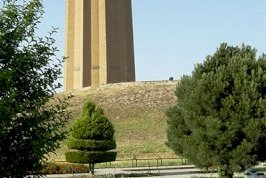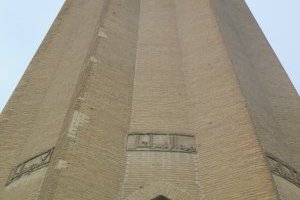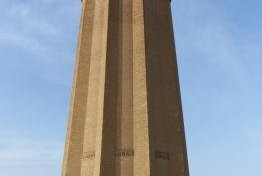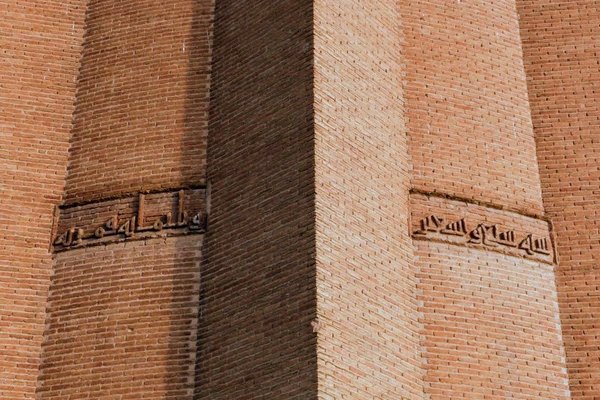Iran
Gonbad-e Qâbus
Gonbad-e Qābus is a monumental tomb tower that is an outstanding achievement of early Islamic brick architecture.
The 53 metres high tower was constructed to an intricate geometric plan so the brickwork could bear the load. Its form is cylindrical with a conical roof, which became the prototype for the construction of tomb towers in the wider region. It was built in 1006 as a tomb for emir Qābus ibn Voshmgir, but no traces of remains have been found inside the tower.
Community Perspective: This one is a long way off the route for visiting Iran’s other WHS. For a fee, you can enter the enclosure and climb its mound. After around half an hour and a few circumambulations, you will have seen it.
Site Info
Official Information
- Full Name
- Gonbad-e Qâbus (ID: 1398)
- Country
- Iran
- Status
-
Inscribed 2012
Site history
History of Gonbad-e Qâbus
- 2012: Inscribed
- Inscribed
- Type
- Cultural
- Criteria
- i
- ii
- iii
- iv
Links
- UNESCO
- whc.unesco.org
- Official
-
- itto.org — Iran Tourism & Touring
- Related
-
- iranicaonline.org — Encyclopaedia Iranica
All Links
UNESCO.org
- whc.unesco.org — whc.unesco.org/
Official Website
- itto.org — Iran Tourism & Touring
Related Resources
- iranicaonline.org — Encyclopaedia Iranica
News Article
- Dec. 17, 2024 tehrantimes.com — Gonbad-e Qabus undergoes restoration amid concerns over vertical cracks
- April 17, 2022 tehrantimes.com — Gonbad-e Qabus restoration may take two years
Community Information
- Community Category
- Secular structure: Burial
Travel Information
Red Zone Travel Advisory
Recent Connections
-
Untranslated Toponyms
"Gonbad" is a Farsi word that means a d… -
Named after individual people
"Built in AD1006 for Qabus ibn Voshmgir… -
Red Zone Travel Advisory
Iran fully off-limits
Connections of Gonbad-e Qâbus
- Individual People
-
-
Sir Wilfred Thesiger
June - August 1964See prmprints.com
-
- History
-
-
Silk Roads
Classic Land Route; "Jorjan town was commercially significant in the Roman period due to its location on the Silk Road between Merv and Ctesiphon" (AB ev)
-
- Architecture
-
-
Muqarnas
stalactites works (moqarnass) of the entrance (nom file) -
Brick architecture
baked-brick -
Conical roofs
-
- Damaged
-
-
Damaged in World War I
"Damage to the brickwork of the tower had occurred during WWI and in 1928 restoration works were carried out" (AB)
-
- World Heritage Process
-
-
Single Monuments
Also meets criterion i: masterpiece of human creative genius. -
Perfect Inscriptions
2012
-
- Constructions
-
-
Tombs
Tower was built as a tomb, although no human remains have been found inside
-
- Timeline
- Science and Technology
-
-
Mathematical Concepts
Cycles and Circumferences. "The monument is an outstanding example of an Islamic commemorative tower whose innovative structural design illustrates the exceptional development of mathematics and science in the Muslim world at the turn of the first millennium AD." - statement of OUV
-
- Visiting conditions
-
-
Red Zone Travel Advisory
Iran fully off-limits
-
- WHS Names
-
-
Untranslated Toponyms
"Gonbad" is a Farsi word that means a dome or a domed building. It is often used to describe the architectural style of mausoleums, palaces, mosques, and fire-temples. -
Named after individual people
"Built in AD1006 for Qabus ibn Voshmgir, Ziyarid ruler and literati" (UNESCO Web site). SeeSee en.wikipedia.org
-
News
- tehrantimes.com 12/17/2024
- Gonbad-e Qabus undergoes restorati…
- tehrantimes.com 04/17/2022
- Gonbad-e Qabus restoration may tak…
Community Reviews
Show full reviews
The Gonbad-e Qābus, meaning “Dome of Qābus,” was visited on Friday, 16 May 2014, on a three-day extension of a guided tour of Iran. It had been the subject of an art history master’s degree thesis in 1966, so there was a long term wish to visit what is said to be Earth’s tallest tower of unglazed, fired brick and one the the earliest Iranian monuments bearing its date and the name of the Ziyarid dynasty emir responsible for its construction.
The tower was first designated a protected monument under Iran’s Law for Protection of National Heritage in 1930. In 1975 it was cited by the Iranian Cultural, Heritage, Handicraft and Tourism Organization (ICHHTO) as number 1097. In 2012, it was declared a UNESCO World Heritage Site with the number, 1398.
Today, the tower sits off center atop an artificial hill measuring 10m in height in the center of the city of Gonbad-e Kāvus, located in Golestan province in northeastern Iran near the Turkmenistan border to the north and the Caspian Sea to the west. Originally the tower stood 3km from the ancient Ziyarid dynasty capital city of Gurgan which was destroyed in the 14th-15th centuries CE. Sitting in a park in the city which has grown up around it largely since the Revolution, the monument remains as the only remanent of the dynasty that one ruled most of northeastern Iran.
The inscription in Kufic style Arabic, built into the brick fabric of the tower and duplicated …
Keep reading 0 comments
A lot has been said in the below review that I can't really add much. The site is remote, even with he nearby forests/parks probably WHS soon, as well the “on paper” great wall of Gorgan to visit.
I found a parking lot right at the site which acts as a fairground in summer. It also taught me that parking on the side of the road you need to be careful of the large gaps between road and side that act as...drainage? It was rainy but nothing compared to the snowy road from the south that had many people grabbing their snow chains quickly. So I made made it to the tower and looks pretty impressive but woah there is so little to see. I find myself reviewing bad sites more often but I suppose there are so many reviews for the “good” places. I am actually dishing out more stars than what is worth but I like towers.
Indeed you get a leaflet about the site, walk up the ramp and read a couple of panels. Inside, I was so excited, is absolutely nothing! Well, air, and darkness, and a ceiling somewhere up there. If not for that I would probably be ok taking a picture from just outside the entrance like everyone else! So I spend a few more minutes walking around the tower, read the labs again, took more pictures and goodbye tower. I think I spent more time writing the review.
As I …
Keep reading 0 comments
A quick look at the map of Iran will indicate why Gonbad-e Qabus might not yet have been reviewed on this web site and indeed had only 5 recorded visits prior to ours! It is a long way off the route for visiting Iran’s other WHS! Which was a problem for us, as I had set myself the objective of visiting all of Iran’s WHS, other than Shahr-i Sokhta. So I swallowed hard and added 2 days to the end of our circular trip by car after taking in the other 17 – a distance from Tehran of over 500 kms each way. Over 1000 kms just to see a brick “tower”!??
Well – was it worth it? In purely objective terms I guess the answer must be “no” – even for that extra tick! But the trip contained enough other “interests” by taking us to a “new” area of Iran to make it just about worthwhile. Our outward journey took us past 5620m Mt Damavand and down to the Caspian coast at 24m below sea level! Gonbad itself is approached across a plain of wheat fields which predominate in this area SE of the Caspian. To the south, the hazy Elburz mountains create an amazing climatic change – across them, less than 100kms as the crow flies, lies largely empty “desert” Iran. On this side, the mountain slopes are forested and farmers tend rice paddy fields which look as if they could be in SE Asia. The next …
Keep reading 0 comments
